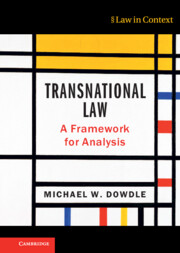4 results
5 - Law and the State
-
-
- Book:
- The Cambridge Comparative History of Ancient Law
- Published online:
- 09 May 2024
- Print publication:
- 30 May 2024, pp 181-230
-
- Chapter
- Export citation
29 - Transnational Regulation
- from Part IV - Comparative Law beyond the State
-
-
- Book:
- The Cambridge Handbook of Comparative Law
- Published online:
- 26 January 2024
- Print publication:
- 01 February 2024, pp 575-593
-
- Chapter
- Export citation

The Cambridge Handbook of Comparative Law
-
- Published online:
- 26 January 2024
- Print publication:
- 01 February 2024

Transnational Law
- A Framework for Analysis
-
- Published online:
- 12 November 2022
- Print publication:
- 08 September 2022
-
- Textbook
- Export citation

